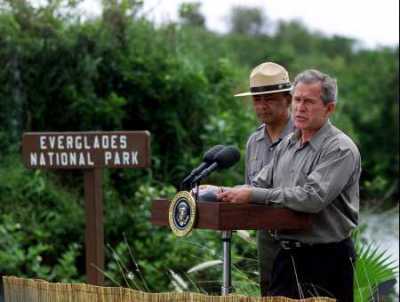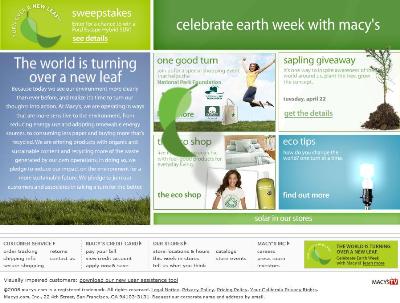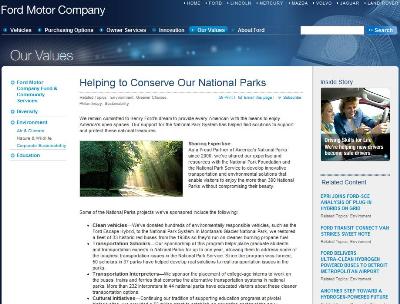
Parks’ campaigns hope for big results
It can be a daunting task for a system of nearly 400 national parks, preserves and historical landmarks to support itself financially and make its resources known to the public, and understandably even more so considering it is prevented from advertising.
But that’s where ingenuity and outside organizations that work with the parks system come into play.
Still, Jeffrey Olson, public affairs officer for the National Park Service in Washington, D.C., says it can be difficult to reach the public, especially the current instant-gratification generation.
| President George W. Bush stands with NPS employee Jerry Belson at Everglades National Park. (Photo courtesy of National Park Service). |
 |
“We know we’re in a competition with video games, movies and theme parks [for kids’ attention],” he said, admitting reaching any specific demographic is also problematic for the NPS.
“It is a little difficult to reach out directly. [To say] here’s a group of people we need to reach out to directly.”
Indirectly reaching the masses, however, can be easier at times due to inherent media attention of the parks.
“Who we are is one of the ways we stay in the popular press and stay in the websites, the fact we are national parks,” Olson said. “When we do things people like, we get in the news. When we do things people don’t like, we get in the news.”
The parks themselves offer what they call personal and non-personal interpretive services, which aim to educate the public about the natural and cultural resources involved.
According to Bob DeGross, Big Cypress National Preserve public affairs officer, personal interpretive efforts include traditional ranger-led swamp walks and park officials speaking at different clubs and meetings. Non-personal interpretation includes informational signage in the parks and individual parks’ websites.
But the parks’ efforts are confined to educating the public, DeGross, whose preserve is located north of the Everglades National Park in South Florida, said.
“There’s a law that prevents us from using advertising firms to try and get our message out,” he said. “That stems primarily from the fact the government doesn’t want to spend the money on that. We do it through partnerships.”
| Macy’s recently partnered with the National Park Foundation to offer special shopping days encouraging donation to the NPF (Screen capture courtesy of Macy’s and macys.com) |
 |
One official partner of the NPS, the National Park Foundation, raises private funds through corporate partnerships and other means to provide grants that help improve and preserve the parks as well as increase public awareness.
The foundation is charted by the U.S. Congress and describes itself as the national charitable partner of the National Park Service.
“We encourage private citizens to support their national parks,” Anne Marek, NPF Media and Public Affairs director, said.
She said the NPF (http://www.nationalparks.org) uses Parks magazine, events, direct mail and its online newsletter to reach the general public.
The NPF also seeks out corporate partnership in order to generate funds. A recent partnership with Macy’s came through such corporate outreach. As part of the campaign, which took place around Earth Week, Macy’s encouraged customers to donate to the NPF in exchange for merchandise discounts.
Macy’s also offered an eco-friendly tote bag and donated part of the proceeds to the NPF. The campaign also involved a tree planting initiative and a sweepstakes offering trips to national parks.
“Goals of the partnership [with Macy’s were] to educate, raise awareness and generate funds to support our parks,” Marek said. Macy’s also stood to benefit through increased sales and good public relations.
The NPF uses both corporate and private contributions to target groups such as children and specific clubs like bike riders and kayakers that the NPS can’t.
“The foundation funds youth and education programs like First Bloom, Junior Rangers and the Electronic Field Trip program that introduce America’s children to our national parks,” Marek said.
| The National Park Foundation enlists several major corporations as Proud Partners, including Ford Motor Company, (Screen capture courtesy of Ford Motor Company and ford.com). |
 |
“[We also fund] sustainability programs like Transportation Scholars that enable transportation experts to help resolve some of the most significant transportation challenges in our national parks[and] volunteer programs like Trail Restoration that provide better access to our national parks and many other important efforts that help ensure our nation’s most treasured settings are preserved for the enjoyment of all Americans,” she said.
Other groups like the National Parks Conservation Association (http://www.ncpa.org) target advocacy efforts more toward legislators who make decisions about park funding and programs.
“Our media relations campaigns are intended to win greater protections and federal funding for parks; we do not aim to engage the general public,” said Andrea Keller, senior director of Media Relations for the NPCA. “Instead, we target specific media in specific markets that can influence and inspire decision makers to better care for our national parks.”
The NPCA decides to support certain government programs and initiatives regarding the parks. It is currently supporting the proposed 40-mile “greenway” bike path connecting Biscayne and Everglades national parks in South Florida.
“Once our regional and legislative staff assess the proposal, NPCA staff share our position as appropriate with local media, decision-makers, the park service, local and state agencies, and any other relevant constituencies through press outreach, fact sheets, meetings and other outreach tactics relevant to the situation,” Keller said.
The NPS also maintains partnerships with the 65 individual associations, such as the Everglades Association, that aim to ensure each of the national parks’ long term preservation and care.
“We run the visitors’ centers,” Everglades Association president and chief operating officer Cal Singletary said.
According to Singletary, the associations contributed around $37 million to the parks themselves last year through running the visitors’ centers and selling informational materials.
“We do the publications, we do the newspapers, we work with the public to educate them [about the parks],” he said.
But even with such a complex system of support in place, accomplishing the parks’ goals is still easier said than done in many cases. In South Florida, one problem is getting people to recognize the parks service, DeGross said.
“People down here are more focused on the beaches than the interior,” he said. “There are areas right next door that make up their backyard that are known worldwide that a lot of these people in the urban areas of South Florida don’t recognize.
“A lot of times people drive through and say ‘Why isn’t this developed?’ ” DeGross stated. “We help people understand why they’re set aside as national preserves.”

Comments are Closed